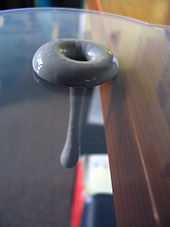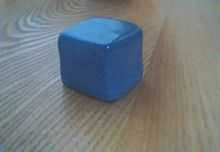Silly Putty

Silly Putty is a toy based on silicone polymers that have unusual physical properties. It bounces, but breaks when given a sharp blow and can also flow like a liquid. It contains a viscoelastic liquid silicone, a type of non-Newtonian fluid, which makes it act as a viscous liquid over a long time period but as an elastic solid over a short time period. It was originally created by accident during research into potential rubber substitutes for use by the United States in World War II.
The name Silly Putty is a trademark of Crayola LLC; the company's factory is based in Easton, Pennsylvania, USA. Other names are used to market similar substances from other manufacturers.
Description

As a bouncing putty, Silly Putty is noted for its unusual characteristics: it bounces, but breaks when given a sharp blow; it can also float in a liquid and will form a puddle given enough time. Silly Putty and most other retail putty products have thixotropic agents added to reduce the flow and enable the putty to hold its shape.
The original coral-colored Silly Putty is composed of 65% dimethyl siloxane (hydroxy-terminated polymers with boric acid), 17% silica (crystalline quartz), 9% Thixatrol ST (castor oil derivative), 4% polydimethylsiloxane, 1% decamethyl cyclopentasiloxane, 1% glycerine, and 1% titanium dioxide.[1]
Silly Putty's unusual flow characteristics are due to the ingredient polydimethylsiloxane (PDMS), a viscoelastic liquid. Viscoelasticity is a type of non-Newtonian flow, characterizing material that acts as a viscous liquid over a long time period but as an elastic solid over a short time period. Because its apparent viscosity increases directly with respect to the amount of force applied, Silly Putty can be characterized as a dilatant fluid.
Silly Putty is also a fairly good adhesive. When newspaper ink was petroleum based, Silly Putty could be used to transfer newspaper images to other surfaces, possibly after introducing distortion. Newer papers with soy-based inks are more resistant to this activity.
Silly Putty will dissolve when in contact with an alcohol; after the alcohol evaporates, the material will not exhibit its original properties.

Generally, Silly Putty is difficult to remove from textured items such as hair and clothing. Hand sanitizers containing alcohol are often helpful. The maker, Crayola, suggests WD-40.[2]
If Silly Putty is submerged in warm or hot water, it will become softer and thus "melt" much faster. It also becomes harder to remove small amounts of it from surfaces. After a long period of time, it will return to its original viscosity.
Silly Putty is sold as a 13 g (0.46 oz) piece of plastic clay inside an egg-shaped plastic container. It is available in various colors, including glow-in-the-dark and metallic. The brand is owned by Crayola LLC (formerly the Binney & Smith company), which also owns Crayola crayons. As of July 2009, twenty thousand eggs of Silly Putty are sold daily. Since 1950, more than 300 million eggs of Silly Putty (approximately 4,500 short tons or 4,100 tonnes) have been sold.[3] Other brands offer similar materials in larger size containers and in a wide variety of colors, such as pink, blue and yellow, or with different properties, such as magnetism and iridescence.
History
During World War II, Japan invaded rubber-producing countries as they expanded their sphere of influence in the Pacific Rim. Rubber was vital for the production of rafts, tires, vehicle and aircraft parts, gas masks, and boots. In the U.S., all rubber products were rationed; citizens were encouraged to make their rubber products last until the end of the war and to donate spare tires, boots, and coats. Meanwhile, the government funded research into synthetic rubber compounds to attempt to solve this shortage.[4]
Credit for the invention of Silly Putty is disputed[5] and has been attributed variously to Earl Warrick, of the then newly formed Dow Corning; Harvey Chin; and James Wright,[6] a Scottish inventor working for General Electric in New Haven, Connecticut.[7] Throughout his life, Warrick insisted that he and his colleague, Rob Roy McGregor, received the patent for Silly Putty before Wright did; but Crayola's history of Silly Putty states that Wright first invented it in 1943.[4][8][9] Both researchers independently discovered that reacting boric acid with silicone oil would produce a gooey, bouncy material with several unique properties. The non-toxic putty would bounce when dropped, could stretch farther than regular rubber, would not go moldy, and had a very high melting temperature.
Wright found that the substance did not have all the properties needed to replace rubber, so it was not used for any purpose. In 1945 Wright sent samples to scientists all around the world, but no practical use was ever found.
In 1949, the putty reached the owner of a toy store, Ruth Fallgatter. She contacted Peter Hodgson, a marketing consultant. The two decided to market the bouncing putty by selling it in a clear case. Although it sold well, Fallgatter did not pursue it further. However, Hodgson saw its potential.
Already $12,000 in debt, Hodgson borrowed $147 to buy a batch of the putty to pack 1 oz (28 g) portions into plastic eggs for $1, calling it Silly Putty. After selling over 250,000[10] eggs of silly putty in three days, Hodgson was almost put out of business in 1951 by the Korean War. Silicone, a main ingredient in silly putty, was put on ration, harming his business. A year later the restriction on silicone was lifted and the production of Silly Putty resumed.[3] Initially, it was primarily targeted towards adults. However, by 1955 the majority of its customers were aged 6 to 12. In 1957, Hodgson produced the first televised commercial for Silly Putty, which aired during the Howdy Doody Show.
In 1961, Silly Putty went worldwide, becoming a hit in the Soviet Union and Europe. In 1968, it was taken into lunar orbit by the Apollo 8 astronauts.
Peter Hodgson died in 1976. A year later, Binney & Smith, the makers of Crayola products, acquired the rights to Silly Putty. By 1987, annual Silly Putty sales exceeded two million eggs.
Silly Putty was inducted into the National Toy Hall of Fame in 2001.
Other uses
After its success as a toy, other uses were found. In the home, it can be used to remove substances such as dirt, lint, pet hair, or ink from various surfaces. The material's unique properties have found niche use in medical and scientific applications. Physical therapists use it for rehabilitative therapy of hand injuries. A number of other brands (such as Power Putty and TheraPutty) alter the material's properties, offering different levels of resistance. The material is also used as a tool to help reduce stress, and exists in various viscosities based on the user's preference. Because of its adhesive characteristics, it was used by Apollo astronauts to secure their tools in zero-gravity.[11] Scale model building hobbyists use the putty as a masking medium when spray painting model assemblies.[12]
See also
References
- ↑ "The Synthesis of Bouncing Putty". Western Oregon University. Retrieved 27 February 2015.
See patent pages
- ↑ Crayola Stain Removal Tips
- ↑ 3.0 3.1 "Silly Putty History". Crayola LLC. Retrieved March 28, 2013.
- ↑ 4.0 4.1 "Silly Putty Timeline". Binney & Smith. Archived from the original on 2009-04-22. Retrieved 2009-10-21.
- ↑ New York Times Obituary, November 22, 2002
- ↑ The 20 most fascinating accidental inventions
- ↑ The Big Book of Boy Stuff, page 88. ISBN 1-58685-333-3
- ↑ U.S. Patent 2,431,878 - Treating dimethyl silicon polymer with boric acid
- ↑ U.S. Patent 2,541,851 - Process for making puttylike elastic plastic, siloxane derivative composition containing zinc hydroxide
- ↑ Chemical & Engineering News: What's That Stuff? Silly Putty
- ↑ Timeless Toys by Tim Walsh, page 92. ISBN 0-7407-5571-4
- ↑ Scale Auto Magazine, various issues
External links
| Wikimedia Commons has media related to Silly Putty. |